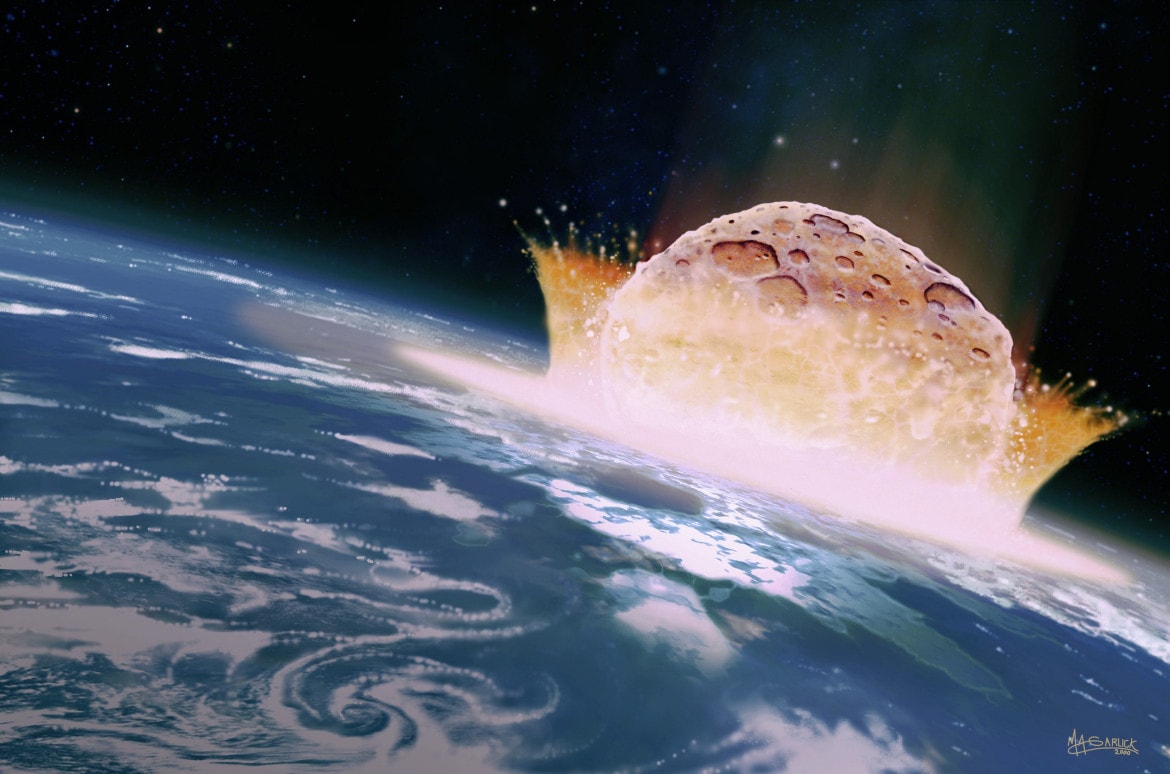Scientists Say Dinosaur-Killing Asteroid Made Earth’s Surface Act Like Liquid
 A computer illustration of a large asteroid colliding with Earth. (Size may not be to scale.) Such an impact is believed to have led to the death of the dinosaurs some 66 million years ago. (Photo: Mark Garlick )
A computer illustration of a large asteroid colliding with Earth. (Size may not be to scale.) Such an impact is believed to have led to the death of the dinosaurs some 66 million years ago. (Photo: Mark Garlick )
Published November 25th, 2016 at 3:00 PM
When the asteroid believed to have killed off the dinosaurs smashed into Earth some 66 million years ago, its sheer force made the planet’s surface momentarily act like a liquid.
The asteroid ripped open a 60-mile-wide hole. From miles deep in that abyss, rock hurtled upward to a height twice that of Mount Everest and then collapsed outward to form a ring of mountains.
And it all happened within 5 minutes — 10 tops, as Sean Gulick, a geophysicist at the University of Texas, Austin, tells The Two-Way.
Gulick helped lead a team of researchers that drilled for samples of that mountain ring in the Chicxulub crater off the coast of Mexico earlier this year. Their initial findings were recently published in the journal Science.
He says these samples immediately settled a major debate about how a planet’s surface behaves during an asteroid impact — and how the mountain ring, known as a “peak ring,” is formed.
Some researchers have argued that the process is dominated by melting on the surface, which would mean that the ring is mainly formed from material moving from side-to-side. “So things collapse in from the sides, fairly shallow, and in that model this ring of peaks are created by shallow material kind of moving towards the center and being uplifted,” he says.
Others have suggested that it was a much more dramatic kind of movement, involving the fluid-like propelling of material from deep within the Earth’s crust. Gulick says there was a very clear moment during the expedition when the team knew this theory was correct.
“It was just so obvious, even on the drill floor when we’re out there, out in our hard hats and so on, looking at these cores coming up,” Gulick says. The researchers were seeing pink granite that is typically found deeper within the Earth — and not the limestone that would have been on the surface during the Cretaceous Period.
“And it was just plain as day,” he says, “and everybody staring at it went, ‘Wow, there’s the answer. It’s from deep.’ ”
Gulick likens the rapid process to what happens when you toss a rock into a pond:
“It makes a hole initially as the rock penetrates into the pond. And the sides will sort of collapse inward toward the hole while the center kind of rebounds up like a big water droplet rising up.
“If you picture all of this happening in a slightly slower-moving fluid than water would be, you can envision that the center that rebounds upwards and splashes upwards would kind of collapse outwards. So just as the sides are falling in, this rebounding center is sort of collapsing outwards to create … this ring of mountains, made from material that ultimately came from fairly deep.”
It’s worth noting that even though the rock behaved like liquid, Gulick says it remained solid. However, the materials were “either shocked or damaged so much that they’re able to temporarily lose their cohesion and move like a slow-moving fluid.” Big questions remain about how that physical process actually works, he says.
The pink granite that emerged from about 6 miles deep in the Earth might provide hints about how life came back to ground zero after the asteroid’s impact erased most of the species on the planet.
The rock is “completely shot through with fractures and faults,” and is much more porous and less dense than typical granite, Gulick says. Those nooks and crannies could have provided a habitat for microbial life. He says the “pore spaces and the hot fluids and the interesting chemistry that takes place in the wake of an impact” could be hospitable to these microscopic creatures.
Gulick’s team thinks the fluid-like movement “is probably the right way to think about impact processes” on the moon or on crater-laden planets such as Mercury or Venus.
And he says that if we’re looking for evidence of life on other planets, these findings indicate that crater sites would be a good place to start.
9(MDA1MjcyMDE0MDEyNzUzOTU1NTMzNmE5NQ010))

